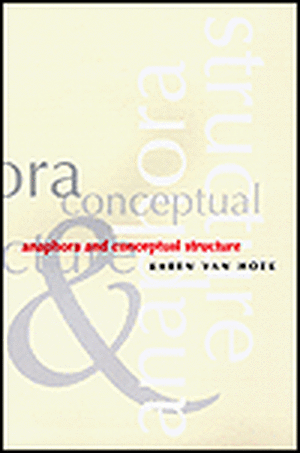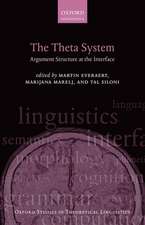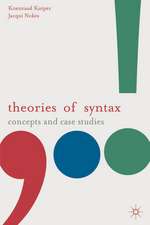Anaphora and Conceptual Structure: Cognitive Theory of Language and Culture Series
Autor Karen Van Hoeken Limba Engleză Paperback – 10 sep 1997
Karen van Hoek presents a cogent analysis of the classic problem of constraints on pronominal anaphora within the framework of Cognitive Grammar. Van Hoek proceeds from the position that grammatical structure can be characterized in terms of semantic and phonological representations, without autonomous syntactic structures or principles such as tree structures or c-command. She argues that constraints on anaphora can be explained in terms of semantic interactions between nominals and the contexts in which they are embedded.
Integrating the results of previous work, Van Hoek develops a model in which some nominals function as "conceptual reference points" that dominate over stretches defined by the semantic relations among elements. When a full noun is in the domain of a reference point, coreference is ruled out, since the speaker would be sending contradictory messages about the salience of the noun's referent.
With profound implications for the nature of syntax, this book will interest theoretical linguists of all persuasions.
Integrating the results of previous work, Van Hoek develops a model in which some nominals function as "conceptual reference points" that dominate over stretches defined by the semantic relations among elements. When a full noun is in the domain of a reference point, coreference is ruled out, since the speaker would be sending contradictory messages about the salience of the noun's referent.
With profound implications for the nature of syntax, this book will interest theoretical linguists of all persuasions.
Preț: 382.38 lei
Nou
Puncte Express: 574
Preț estimativ în valută:
73.18€ • 75.60$ • 60.90£
73.18€ • 75.60$ • 60.90£
Carte tipărită la comandă
Livrare economică 25 martie-08 aprilie
Preluare comenzi: 021 569.72.76
Specificații
ISBN-13: 9780226848945
ISBN-10: 0226848949
Pagini: 263
Ilustrații: 16 line drawings
Dimensiuni: 152 x 229 x 18 mm
Greutate: 0.37 kg
Ediția:1
Editura: University of Chicago Press
Colecția University of Chicago Press
Seria Cognitive Theory of Language and Culture Series
ISBN-10: 0226848949
Pagini: 263
Ilustrații: 16 line drawings
Dimensiuni: 152 x 229 x 18 mm
Greutate: 0.37 kg
Ediția:1
Editura: University of Chicago Press
Colecția University of Chicago Press
Seria Cognitive Theory of Language and Culture Series
Notă biografică
Karen van Hoek is assistant professor of linguistics at the University of Michigan.
Cuprins
Preface and Acknowledgments
1. Introduction
1.1. The Issue
1.2. The Conceptual Basis of the Constraints
1.3. The Nature and Limitations of C-Command
1.4. The Relationship between Syntax and Discourse
2. Theoretical Foundations
2.1. Introduction to Cognitive Grammar
2.2. Desiderata for a Model of Anaphora Constraints
2.3. Nominal Semantics
2.4. Anaphora Constraints and Grammaticality Judgments
3. Reference Points and the Complement Chain
3.1. Defining the Relevant Contexts
3.2. Reference Points and Dominions
3.3. The Complement Chain
3.4. POV Shifts and the Complement Chain
3.5. Summary
4. Conceptual Connectivity
4.1. Conceptual Connectivity
4.2. Modifiers Inside and Outside the Process Conception
4.3. Preposed Modifiers
4.4. Summary
5. Beyond the Anaphora Constraints
5.1. Backwards Anaphora
5.2. The Prototypical Configuration
5.3. The Pronoun as Peripheral Element
5.4. Repeat Identification
5.5. Summary
5.6. Anaphora in Discourse
5.7. Summary
6. Bound Anaphora
6.1. Quantifier Semantics
6.2. Bound Anaphora
6.3. The Replicate Process Conception
6.4. Reference Point Organization within the Complement Chain
6.5. The Antecedent as Reference Point
6.6. Summary
7. Reflexives
7.1. Reflexives and Pronouns
7.2. Prototypical Values of the Reflexive
7.3. The Schematic Reflexive Configurations
7.4. Extension from the Emphatic Reflexive
7.5. Near Extensions from the Reflexive Prototype
7.6. POV Reflexives
7.7. Constraints on Distribution of Reflexives
8. Point of View
8.1. The Relationship between Reference Point and POV
8.2. POV Dominions
8.3. Viewing within the Complement Chain
8.4. Shifting between Spaces
8.5. Summary
Conclusion
9.1. Guiding Assumptions
9.2. Nominal Semantics
9.3. Interaction of Schemas
9.4. Conceptual Factors in Reference Point Organization
9.5. Cross-linguistic Applicability
9.6. Applications beyond Anaphora
9.7. Summary
Notes
References
Index
1. Introduction
1.1. The Issue
1.2. The Conceptual Basis of the Constraints
1.3. The Nature and Limitations of C-Command
1.4. The Relationship between Syntax and Discourse
2. Theoretical Foundations
2.1. Introduction to Cognitive Grammar
2.2. Desiderata for a Model of Anaphora Constraints
2.3. Nominal Semantics
2.4. Anaphora Constraints and Grammaticality Judgments
3. Reference Points and the Complement Chain
3.1. Defining the Relevant Contexts
3.2. Reference Points and Dominions
3.3. The Complement Chain
3.4. POV Shifts and the Complement Chain
3.5. Summary
4. Conceptual Connectivity
4.1. Conceptual Connectivity
4.2. Modifiers Inside and Outside the Process Conception
4.3. Preposed Modifiers
4.4. Summary
5. Beyond the Anaphora Constraints
5.1. Backwards Anaphora
5.2. The Prototypical Configuration
5.3. The Pronoun as Peripheral Element
5.4. Repeat Identification
5.5. Summary
5.6. Anaphora in Discourse
5.7. Summary
6. Bound Anaphora
6.1. Quantifier Semantics
6.2. Bound Anaphora
6.3. The Replicate Process Conception
6.4. Reference Point Organization within the Complement Chain
6.5. The Antecedent as Reference Point
6.6. Summary
7. Reflexives
7.1. Reflexives and Pronouns
7.2. Prototypical Values of the Reflexive
7.3. The Schematic Reflexive Configurations
7.4. Extension from the Emphatic Reflexive
7.5. Near Extensions from the Reflexive Prototype
7.6. POV Reflexives
7.7. Constraints on Distribution of Reflexives
8. Point of View
8.1. The Relationship between Reference Point and POV
8.2. POV Dominions
8.3. Viewing within the Complement Chain
8.4. Shifting between Spaces
8.5. Summary
Conclusion
9.1. Guiding Assumptions
9.2. Nominal Semantics
9.3. Interaction of Schemas
9.4. Conceptual Factors in Reference Point Organization
9.5. Cross-linguistic Applicability
9.6. Applications beyond Anaphora
9.7. Summary
Notes
References
Index


















